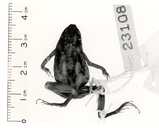|
Micryletta steinegeri (Boulenger, 1909)
Stejneger's Paddy Frog, Stejneger's Narrow-mouthed Toad, Paddy Frog, Taiwan Little Pygmy Frog | family: Microhylidae subfamily: Microhylinae genus: Micryletta |
 Photographer Unknown © Museum of Vertebrate Zoology, University of California, Berkeley (1 of 5)
|
|
|
|
Description The tadpole has an ovoid and depressed body. The snout is wide and curved, and the nostrils are positioned on the top of the snout. There is a slightly rounded, prominent groove running between the nostril and the anterior end of the eye. The eyes are horizontal. The mouth is at the very front of the snout and located on the upper half of the body. The lips are curved inward, and the lower lip extends past the upper lip. It has a medioventral spiracle, and the anus is positioned on the midline of the body. The tail fin is filamentous towards the end, and tapers to a pointed tip (Wang et al. 1989). It is similar in appearance to M. inornata, though M. inornata differs in having enlarged toe tips, no webbing on the feet, and a smaller ratio of the distance between the eyes to the upper eyelid width. Tadpoles of M. steinegeri are similar to those of Microhyla ornata, although Microhyla ornata differs in having a convex mouth, lighter coloration, and a more evenly tapered tail fin (Wang et al. 1989). In life, individuals have widely varying coloration. The examined holotype has a purple to orange brown back with a midline that runs from between the eyes to the end of the body. The back may have varying black markings, including stripes, marbling, irregular spots, and/or scarce speckling. The underside is light gray with black marbling. A black stripe runs from the snout tip through the eye, and all the way to the groin. The pupil is black and the iris is golden. The lips are spotted white, though the spotting on the upper lip may form a white line going from the angle of the mouth to the front of the eye. Males have a black throat. The backside of the limbs is orange and spotted black, whereas the undersides are white (Wang et al. 1989). Much of the variation within the species comes from the coloration and markings, though no description is available on the coloration differences within the species. Additionally, females are much larger than males, and males have a vocal sac (Wang et al. 1989). Distribution and Habitat Country distribution from AmphibiaWeb's database: Taiwan
Life History, Abundance, Activity, and Special Behaviors Trends and Threats Relation to Humans Possible reasons for amphibian decline General habitat alteration and loss Comments The species epithet, steinegeri, is named after Dr. L. Stejneger, author of the valuable monograph Herpetology of Japan and adjacent territories (Boulenger 1909). Micryletta steinegeri was first described by Boulenger in 1909, as Microhyla steinegeri. Subsequently, in 1931, Okada thought that M. steinegeri might be a junior synonym for Microhyla fissipes, as described by Boulenger in 1884. In 1934, Parker instead synonymized M. steinegeri with M. inornata, though with reservation. In 1999, Fei removed M. steinegeri from synonymy with M. inornata (Boulenger 1884, Boulenger 1909, Fei 1999, Okada 1931, Parker 1934).
References
Boulenger, G. A. (1884). ''Descriptions of new species of reptiles and batrachians in the British Museum. Part II.'' Annals and Magazine of Natural History, series 5, 13, 77396-77398. Boulenger, G. A. (1909). ''Descriptions of four new frogs and a new snake discovered by Mr. H. Sauter in Formosa.'' Annals and Magazine of Natural History, Series 8, 4, 492-495. Fei, L. (1999). Atlas of Amphibians of China. Henan Publishing House of Science and Technology, Zhengzhou. Okada, Y. (1931). The Tailless Batrachians of the Japanese Empire. Imperial Agriculture Experiment Station, Tokyo. Parker, H.W. (1934). A Monograph of the Frogs of the Family Microhylidae. British Museum, London. Stuart, S., Hoffmann, M., Chanson, J., Cox, N., Berridge, R., Ramani, P., Young, B. (eds) (2008). Threatened Amphibians of the World. Lynx Edicions, IUCN, and Conservation International, Barcelona, Spain; Gland, Switzerland; and Arlington, Virginia, USA. Originally submitted by: Tina Cheng and Gordon Lau (first posted 2015-08-18) Edited by: Gordon Lau (2018-12-07) Species Account Citation: AmphibiaWeb 2018 Micryletta steinegeri: Stejneger's Paddy Frog <https://amphibiaweb.org/species/2191> University of California, Berkeley, CA, USA. Accessed Nov 29, 2024.
Feedback or comments about this page.
Citation: AmphibiaWeb. 2024. <https://amphibiaweb.org> University of California, Berkeley, CA, USA. Accessed 29 Nov 2024. AmphibiaWeb's policy on data use. |



 Map of Life
Map of Life